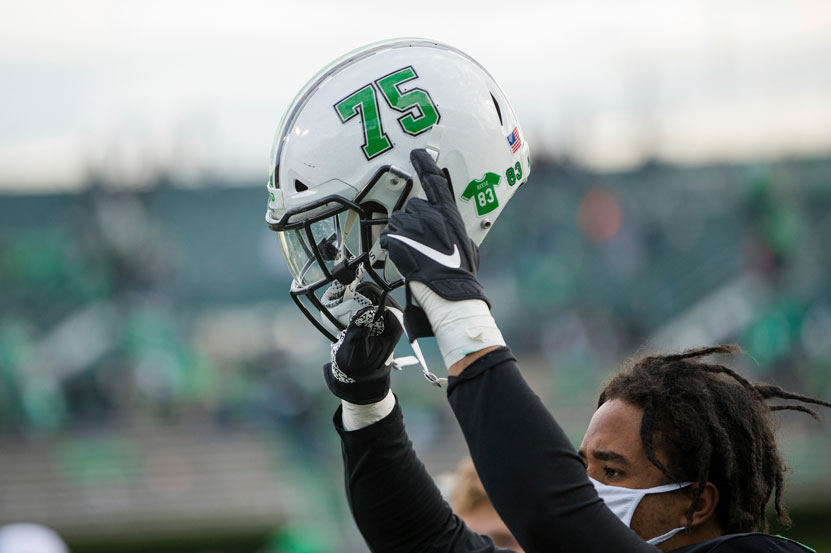In the late 1960s Marshall University’s Thundering Herd was far from a powerhouse, yet spirits in Huntington, West Virginia, were soaring. A new coaching staff had energized the roster, local businesses filled the small stadium every Saturday, and players regularly visited elementary schools to inspire kids in town. Because many team members grew up within a day’s drive, parents, siblings, and friends traveled often to cheer them on, forging a bond between campus and community that felt more like family than fandom.
November 14, 1970: From Game Day Hope to Midnight Silence
That Saturday the Herd lost a hard-fought road game to East Carolina in Greenville, North Carolina. Tired but anxious to return home, seventy-five people—players, coaches, athletic boosters, and flight crew—boarded Southern Airways Flight 932, a chartered DC-9. Heavy rain blanketed the Appalachian foothills, low clouds scraped the hillside, and visibility dropped sharply. At 7:36 p.m. the jet clipped treetops less than a mile short of Tri-State Airport’s runway. Seconds later it sliced through a grove of maples, burst into flames, and crashed into a hollow. No one survived.
Pieces of goal-post tape, helmets, playbooks, and band instruments were flung across the wet hillside, mixing with burned luggage and fragments of the fuselage. Firefighters, stunned by the scale, worked through thick mud and smoke far into the night, hoping for an impossible rescue that never came. Radios carried the awful news across town; porch lights stayed on until dawn as families waited for word that did not arrive.
Shockwaves Through Huntington and Beyond
By sunrise every church bell rang. Classes were canceled, shops locked their doors, and thousands gathered in silence on campus lawns. Nearly an entire starting lineup was gone, along with the head coach, athletic director, and many of the program’s most loyal supporters. For a university of just over 8,000 students, the loss felt unbearable. Twenty-five children were suddenly without a parent. The mayor declared a week of mourning; professors held impromptu counseling sessions in dorm lounges; funeral processions lined traffic for days.
College football fans nationwide grieved too. Letters and telegrams poured in from rival schools, the White House, and even small high-school squads that understood the camaraderie a team can create. The National Collegiate Athletic Association lowered its flag to half-staff; stadiums everywhere observed moments of silence. Sports radio hosts who usually argued over rankings spent entire shows reading condolences.
The Investigation: Searching for Answers
The National Transportation Safety Board launched an immediate inquiry. Their final report, released in 1972, cited several factors:
- Weather: A powerful cold front brought driving rain, low ceilings, and limited visibility.
- Altitude Awareness: Cockpit instruments indicated the jet was below the published glide slope, but the crew apparently did not recognize the descent rate in time.
- Communication Gaps: Controllers and pilots exchanged standard clearances, yet no explicit warning about severe downdrafts near the hilltop approach was issued.
While investigators could not assign a single definitive cause, they concluded that misjudged altitude under challenging weather conditions led to controlled flight into terrain. The findings spurred the Federal Aviation Administration to review approach procedures at similar mountain airports and recommend improved ground-proximity warning systems.
Picking Up the Pieces: Should Football Continue?
In the weeks that followed, Marshall’s president faced an excruciating decision: suspend football indefinitely or try to rebuild. Faculty senate members worried that gridiron glory was trivial next to academic priorities and collective grief. Town leaders argued that reviving the program could help heal emotional wounds. Eventually, amid candlelit vigils and heated town-hall debates, the board of governors voted unanimously to field a team in 1971.
Only a handful of varsity players had not traveled to Greenville. They were joined by junior varsity athletes, walk-ons, and several freshmen granted special eligibility by the NCAA. New head coach Jack Lengyel and athletic director Red Dawson—himself injured and spared because he had recruited elsewhere that weekend—worked around the clock, installing basic playbooks and focusing on fundamentals. The ragtag roster practiced on dusty patches behind old dormitories, borrowing shoulder pads from local high schools. Wins were scarce, but each snap represented resilience.
Memorials, Rituals, and the Annual Fountain Ceremony
Within a year, a five-ton bronze fountain was placed at the center of campus. Designed by sculptor Harry Bertoia, the abstract form suggests both upward-rising hope and falling tears. Every November 14 at precisely 9:43 a.m.—the approximate time classes changed the morning after the crash—the university president extinguishes the fountain’s water. Family members, teammates, and first responders carry white roses to the edge, reading all seventy-five names aloud. The water remains off until the first spring game, symbolizing renewal.
Local landmarks also carry the story:
- Spring Hill Cemetery holds a common grave for six victims who could not be individually identified.
- The Marshall Sports Medicine Institute displays jerseys and personal items donated by relatives.
- Jones C. Edwards Stadium reserves a block of seventy-five empty seats behind the home bench.
Cultural Legacy: Books, Songs, and “We Are Marshall”
The tragedy inspired documentaries, memoirs, and folk ballads throughout the 1970s and 1980s. In 2006 the feature film We Are Marshall introduced the story to a new generation, highlighting both heartbreak and the determination to rebuild. Former players acted as on-set consultants, and the movie’s premiere doubled as a campus fundraiser for scholarships honoring the victims. Each time the phrase “We are… Marshall!” echoes through theaters or stadiums, alumni see it as more than a chant; it is a promise never to forget.
Long-Term Impact on College Athletics and Air Travel
Beyond its local significance, the crash prompted broader changes:
- Team Travel Policies: Many universities now split large rosters across multiple flights or add mandatory rest stops on long bus journeys.
- Mental-Health Support: Athletic departments expanded counseling services, recognizing that sudden loss can ripple through an entire student body.
- Aviation Upgrades: The FAA accelerated deployment of ground-proximity warning alerts, later credited with preventing numerous hillside collisions.
The NCAA also created protocols to assist schools facing catastrophic events, offering temporary eligibility waivers, financial grants, and scheduling flexibility.
Stories of Courage and Rebirth
Survivors’ families often describe mixed emotions—pride in public remembrance paired with private sorrow. Some children of fallen players pursued nursing or firefighting careers, motivated by those who tried valiantly to rescue their parents. Others established scholarships in journalism, engineering, or music, fields their loved ones had planned to enter after graduation. Each award keeps a personal dream alive while nurturing new talent.
The football program’s modern success carries special weight: conference titles in the 1990s, bowl victories, and NFL draft picks stand as proof that heartache can inspire excellence rather than extinguish it. Every touchdown in green and white is celebrated not just for points on a scoreboard but for perseverance rooted in 1970.
Lessons for Today
Fifty-plus years later, the Marshall football crash remains a powerful case study in crisis response, community solidarity, and human resilience. It reminds us that sports are more than wins and losses—they are threads woven into families, towns, and shared identity. The event also underscores aviation’s constant pursuit of safety, showing how tragedy can accelerate technological and procedural advances that safeguard future travelers.
Conclusion: Carrying the Herd’s Legacy Forward
Marshall University will always carry the weight of November 14, 1970, yet the story is ultimately one of hope. A campus once shattered by unthinkable loss now thrives, drawing strength from those who boarded Flight 932. Freshman recruits walk past the bronze fountain on the way to practice, understanding that their jersey carries significance beyond yard lines and statistics. Fans in the stands clap not only for athletic skill but for the spirit of unity that arose from ashes on a rainy hillside.
In remembering the seventy-five, we honor more than lives lost; we celebrate a community’s resolve to rise again—stronger, kinder, and forever undivided.


Leave a Reply